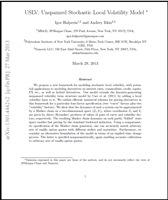
USLV: Unspanned Stochastic Local Volatility Model
Download this Complimentary Numerix Quantitative Research Paper
In this article, we propose a new framework for modeling stochastic local volatility, with potential applications to modeling derivatives on interest rates, commodities, credit, equity, FX etc., as well as hybrid derivatives. Our model extends the linearity-generating unspanned volatility term structure model by Carr et al. (2011) by adding a local volatility layer to it.
We outline efficient numerical schemes for pricing derivatives in this framework for a particular four-factor specification (two "curve" factors plus two "volatility" factors). We show that the dynamics of such a system can be approximated by a Markov chain on a two-dimensional space (Z_t,Y_t), where coordinates Z_t and Y_t are given by direct (Kroneker) products of values of pairs of curve and volatility factors, respectively. The resulting Markov chain dynamics on such partly "folded" state space enables fast pricing by the standard backward induction. Using a nonparametric specification of the Markov chain generator, one can accurately match arbitrary sets of vanilla option quotes with different strikes and maturities.
Furthermore, we consider an alternative formulation of the model in terms of an implied time change process. The latter is specified nonparametrically, again enabling accurate calibration to arbitrary sets of vanilla option quotes.
Authors: Igor Halperin and Andrey Itkin
In this article, we propose a new framework for modeling stochastic local volatility, with potential applications to modeling derivatives on interest rates, commodities, credit, equity, FX etc., as well as hybrid derivatives. Our model extends the linearity-generating unspanned volatility term structure model by Carr et al. (2011) by adding a local volatility layer to it.
We outline efficient numerical schemes for pricing derivatives in this framework for a particular four-factor specification (two "curve" factors plus two "volatility" factors). We show that the dynamics of such a system can be approximated by a Markov chain on a two-dimensional space (Z_t,Y_t), where coordinates Z_t and Y_t are given by direct (Kroneker) products of values of pairs of curve and volatility factors, respectively. The resulting Markov chain dynamics on such partly "folded" state space enables fast pricing by the standard backward induction. Using a nonparametric specification of the Markov chain generator, one can accurately match arbitrary sets of vanilla option quotes with different strikes and maturities.
Furthermore, we consider an alternative formulation of the model in terms of an implied time change process. The latter is specified nonparametrically, again enabling accurate calibration to arbitrary sets of vanilla option quotes.
Authors: Igor Halperin and Andrey Itkin


